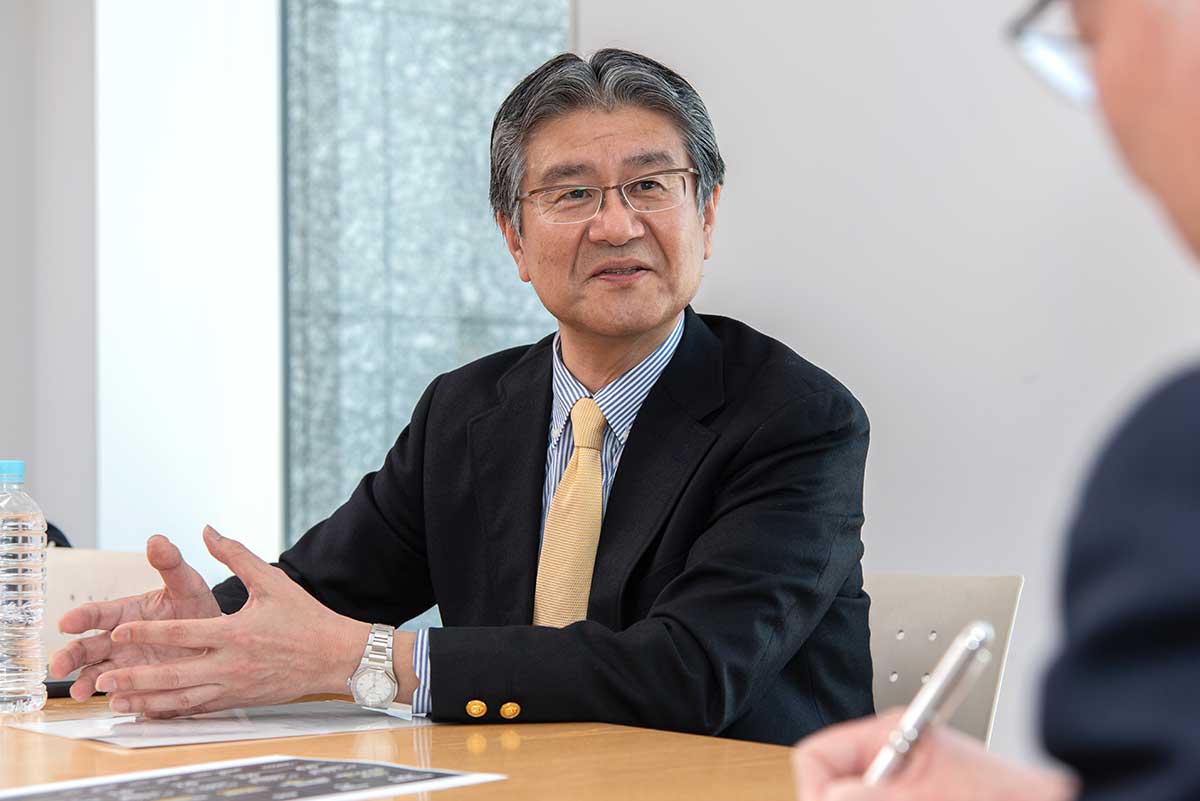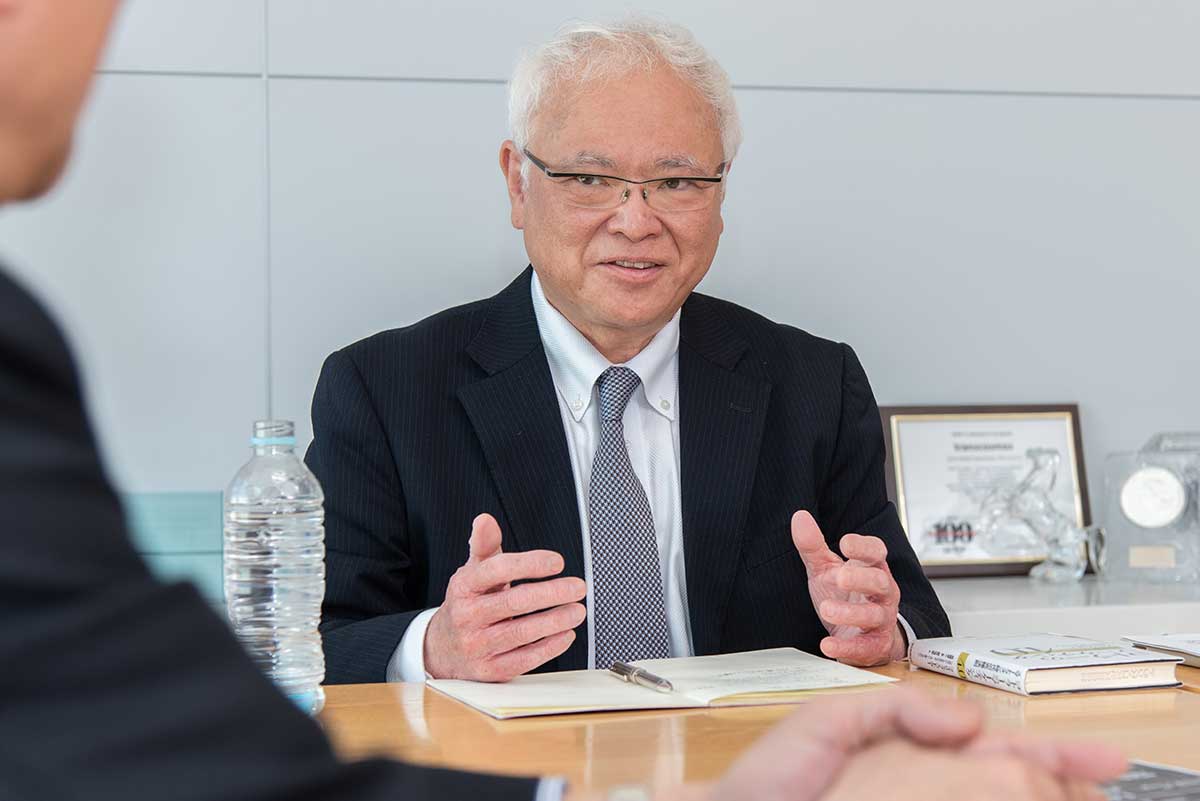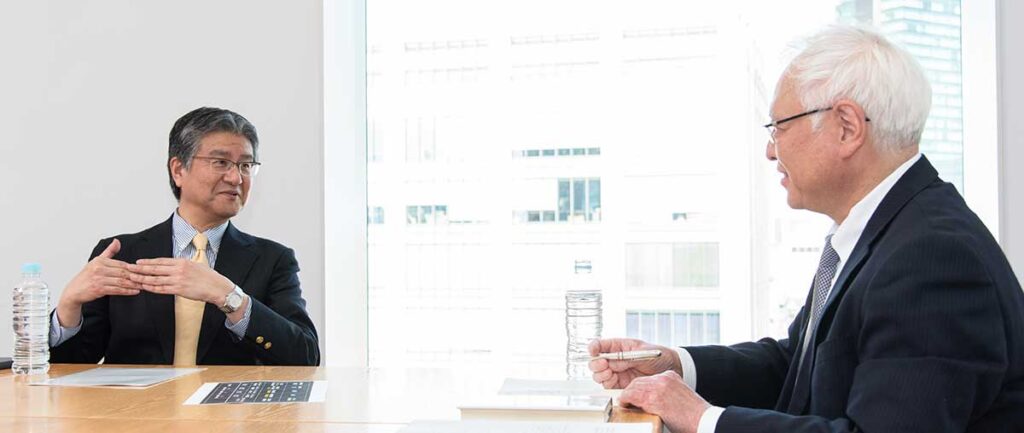transcosmos’ Tsunehiro Fukushima invites guests to discuss the latest marketing situation. For the first session, Mr. Tatsuo Ishii, who joined Kao in 1980 and has been involved in brand marketing for 14 years in the business sector and digital marketing for 13 years, will be invited to discuss the future after “Marketing 4.0,” including past marketing and prospects.

Fukushima:Mr. Ishii is a person who studied the basics of marketing at Kao, the number one company in Japan for training marketers and was an early adopter of digital marketing, in which he succeeded. Mr. Ishii knows both the history and the cutting edge of marketing, and we would like to hear what he has to say about the future of marketing.
Mr. Ishii:In my long involvement in marketing, I feel that marketing is the study and art of market creation. The starting point of market creation is to make customers want to buy products and use services. Based on these ideas, when I look back at Kotler’s marketing theory, there are many points that I can relate to. Let me share with you my experience at Kao.
Contents
Marketing returned to its original form after many years.
 Mr. Ishii:Kao, a company that this year celebrates 130 years in business, began with the desire of its founder, Tomio Nagase, “to have people wash their faces and hands with quality domestic soap to make them clean and healthy. This was a Marketing 1.0 activity, which states that creating a product that solves a customer’s problem will sell. When you create a product that sells well, of course, there will be competitors who will follow suit. This would lead to the era of Marketing 2.0, which conveys the message that our product is different from many other products and that there is a “reason to choose” our product.
Mr. Ishii:Kao, a company that this year celebrates 130 years in business, began with the desire of its founder, Tomio Nagase, “to have people wash their faces and hands with quality domestic soap to make them clean and healthy. This was a Marketing 1.0 activity, which states that creating a product that solves a customer’s problem will sell. When you create a product that sells well, of course, there will be competitors who will follow suit. This would lead to the era of Marketing 2.0, which conveys the message that our product is different from many other products and that there is a “reason to choose” our product.
Kao proposed “Attack” as a compact product that housewives could carry in one hand, instead of a heavy 4.1 kg laundry detergent, and it was immediately chosen by the market despite its high selling price. This is a typical example of Marketing 1.0.
Toothpaste is another clear example of competing “reasons to choose”. Each company aimed to increase sales by segmenting the market, saying, other companies’ products prevent cavities, but our new product has “whitening effects,” or “It prevents bad breath”. This is the Marketing 2.0 strategy. However, as the market became saturated, it became difficult to differentiate recognizable quality and functionality in any field, and it became impossible to provide a “reason to choose” a product based on segmented selling points. In such an era, Kotler advocated Marketing 3.0, Value Creation Marketing.
Social values such as ESG (Environmental, Social, and Governance) and SDGs (Sustainable Development Goals), and emotional values such as “the advertisement of this product fits my sensibility” and “the package fits my lifestyle” are now driving customers to purchase. In other words, at this stage, marketing 1.2 and 2.3 have become the most important elements of marketing. In other words, at this stage, Marketing 1.0 and 2.0, marketing to the unspecified many, has changed to marketing to individuals.
Going further, Marketing 4.0 will provide customers with reasons to choose products and services by attending to each customer’s various modes and moments. For example, a woman who has left her baby with a babysitter and is having dinner with her husband, and is enjoying her wife mode, or “being a wife,” will not accept a digital advertisement for a diaper on her smartphone. If you ignore the customer’s feelings, you will not be close to them, will you? Choosing the optimal moment is the key to self-actualization marketing as Kotler advocates in Marketing 4.0.
However, marketing that manages the customer experience according to the customer’s moment and provides the best timing is not new. In the Edo period (1603-1867), fishmongers who purchased fish at the fish market in Nihonbashi worked hard to sell off the fish they had purchased that day, and to figure out which customers they should sell to and to whom. This is no different from today’s data-driven marketing. Today’s digital marketing utilizes AI and other technologies to process vast amounts of data, but the goal is the same: to provide the best customer experience at the best time for each customer.
The essence of marketing has not changed from the Edo period to the latest. Turning this upside down, it can be said that the days when you could make a product and run a large amount of advertising and people would buy it were a temporary dream, an illusion. This is because the era in which people watched TV advertisements with appreciation was established by an imbalance of information between the company and its customers. This was not the case because the market was not being created by understanding the customer and providing the best service for the customer. With the advent of the Internet and the advancement of digitalization, I believe that we are now back to the original marketing approach of market creation.
 Fukushima:Thank you for sharing your very keen insights. I do believe that the imbalance of information has indeed caused a transitional phenomenon. Until now, manufacturers were able to broadcast their advertisements around the world, while ordinary consumers were not able to disseminate information around the world. Now, however, the Internet and SNS have become available, and the information gap has narrowed dramatically. Naturally, this has changed marketing practices significantly. Until now, it was sufficient to formulate a marketing plan centered on TV advertising, but some brands are now gaining top market share by focusing on online media and OOH (Out of Home media).
Fukushima:Thank you for sharing your very keen insights. I do believe that the imbalance of information has indeed caused a transitional phenomenon. Until now, manufacturers were able to broadcast their advertisements around the world, while ordinary consumers were not able to disseminate information around the world. Now, however, the Internet and SNS have become available, and the information gap has narrowed dramatically. Naturally, this has changed marketing practices significantly. Until now, it was sufficient to formulate a marketing plan centered on TV advertising, but some brands are now gaining top market share by focusing on online media and OOH (Out of Home media).
Mr. Ishii:Companies and customers have equalized the amount of information they have, but now the balance is beginning to reverse. Consider a situation where a customer who enjoys cameras goes to an electronics retail store to purchase a new product. It is a given that the camera hobbyist is more familiar with the differences between other companies’ products than the camera manufacturer’s employees stationed at the store. Moreover, they even have the differences in prices and special offers from other stores in their minds through online searches. In this way, customers are becoming geeks in various areas, and these geeks are transmitting a variety of information via social networking services, which is having a great influence on product purchases. In such an environment, purchasing is no longer the goal, and it has become very important in marketing to generate advocacy (recommendation), in which customers share the empathy and excitement they feel when they use a product with their friends and acquaintances.
Creating a sense of “information familiarity” through precise communication design
Fukushima:There was one keyword that I had a hard time interpreting about Marketing 4.0 advocates. It was “affinity”. I wondered why “affinity” was linked to advocacy, but the people involved in writing the book taught me that it was the “affinity” of information, and I was able to understand it. I am now able to understand it.
Simply saying, “This water tastes good,” is not information you would particularly want to share with others, but when you are told, “This water comes from a water system 300 meters below XX village in Yamanashi Prefecture, where subterranean water from Mt. Fuji for 30 years”, people feel “familiarity” and want to tell their friends and acquaintances, “Hey, this water tastes good. I used to think that it was impossible to control the complexity of information, but now I realize that the way information is conveyed can be changed by the way the manufacturer presents it. It may look like chaos with the advancement of digitalization, but it is not that information is becoming uncontrollable, it is just that conventional management methods are no longer usable.
Mr. Ishii:I believe that a sense of “intimacy” with information can only be achieved when communication is carefully designed to determine to whom and at what time the information will be communicated.
I launched a hair care product called ASIENCE at Kao in 2003. At that time, I tried to control the information gap among customers by using a strategy of “daring to create information gaps. First, I prioritized those with high information sensitivity and the ability to transmit information through digital advertisements and websites, and then passed the information on to their followers. The usual order in which media are used to reach a wide target audience was reversed, and information was sent out with a delay of several weeks, creating a situation in which only those with high information sensitivity knew about the product and wanted to spread the word before the TV ads appeared.
Fukushima:Until now, information dissemination strategies have been based solely on the equation of how much GRP (Gross Rating Point/total viewership of TV commercials) to post and what percentage of viewers to reach. Now, it is necessary to intentionally control how the transmitted information is connected and what kind of penetration process is taken.
Mr. Ishii:The communication strategies of Marketing 1.0 and 2.0 have been solely focused on the goal of reaching and recognizing the target audience, but in fact, these strategies are already falling apart. In the era of Marketing 3.0 and 4.0, the environment surrounding communication has changed like an avalanche due to digitalization. I believe that many marketers are now finally realizing this.
Fukushima:As I have recently been asked by various clients to measure each step of the 5As, I have come to realize the meaninglessness of only chasing reach and awareness. One study showed that the purchase rate of those who became aware of the product on TV was in the single digits, whereas the purchase rate of those who became aware of the product on social networking sites was almost 100%. These results made us keenly aware that awareness is not only a numerical “volume” of recognition but also a “depth” of recognition for each target.
Technology and the Future of Marketing with Marketers
Fukushima:Marketing activities have been limited by the technological environment. The current focus on customer relationship management (CRM) and customer experience (CX) is due to the development of digital technology that enables the acquisition and analysis of vast amounts of data. In addition, in the future, AI technology will naturally be utilized to understand the needs of each customer and to provide hospitality to them in an efficient manner.

If we want to take a bold look at future marketing, we still need to capture the technological trends. I believe that the technological trends that support marketing are riding on one vector. That is the concept of the single source*. Whereas in the past it was only possible to aggregate each piece of data in a single cross-section, now it is possible to track each piece of data on a vertical axis. As this trend progresses, products offered by companies may become more individualized, and marketing communications will naturally become more individualized. Could you tell us your opinion, Mr. Ishii?
*Multifaceted data on purchases, advertising contact, lifestyle, etc., obtained consistently from the same subject
Mr. Ishii:I too believe that the direction in which marketing is moving is toward personalization, even “ultimate personalization”. From the perspective of communication, this is what is depicted in the advertisement in the movie “Minority Report”. In the movie, a scene is depicted in which a street signage system identifies individuals by recognizing the iris of their eyes, understands their past behavioral history, and directs the most appropriate advertisement to them based on their current situation and emotional changes.
In terms of products, Shiseido’s Optune has realized the idea of creating cosmetics formulated on the spot according to each customer’s skin condition and preferences. In other words, an era is coming in which companies will have to offer “ultimate personalization” to customers who are armed with information and have become more selfish. Companies must respond to this environment by utilizing IT and AI in all directions, both in marketing and production.
On the other hand, if AI and other technologies are not backed by a firm vision of “what this brand can be for the customer,” the company will simply create more products and may lose sight of the essence of the value that should be created for the customer. As marketing becomes more and more systemized through AI and IT, we must firmly establish the idea of “what our brand and products can ultimately become for our customers,” and make sure that everyone inside and outside the company involved understands it, so that everything provided to customers will be directed in the same direction. This will ensure that everything provided to the customer is moving in the same direction. Creating a consistent customer experience, I believe, will be the most important job of marketers in future marketing.
Profile of interlocutors
Mr. Tatsuo Ishii After joining Kao in 1980 and working in the sales department, he spent 14 years in the business department working on brand marketing. In the business division, he worked as a brand manager for Merry’s, Laurier, Kitchen Care Products, Biore, ASIENCE, etc. From 2003, he was involved in Kao’s web utilization strategy and planning, and in March 2014, he established the Digital Marketing Center, where he was in charge of Kao’s digital marketing activities until his retirement in January 2017. In March 2014, he established the Digital Marketing Center and managed Kao’s digital marketing activities until his retirement in January 2017. Currently, while serving as an auditor of C Channel K.K., he is an advisor to Adobe Systems Incorporated and e-Life Incorporated, a certified marketing meister of the Japan Marketing Association, a member of the Digital Media Committee of the Japan Advertisers Association, the chairman of the Brand Experience Advertising Dentsu Award Screening Committee, and a member of the Graduate School of Business Administration, Waseda University. He is also a member of the Digital Media Committee of the Japan Advertisers Association, a member of the Brand Experience Advertising Dentsu Award Jury, and a part-time lecturer at Waseda University Graduate School of Business Administration.
Tsunehiro Fukushima He completed his graduate studies at the Tokyo Institute of Technology in 1982. He developed market definition models using multivariate analysis at Ajinomoto Co., Ltd. and was in charge of marketing for the development of new household products and new business development in the marketing department, as well as for a large-scale manufacturing and sales alliance with a convenience store chain. Later, he worked for GE Capital, Mitsubishi Corporation, Gurunavi, and Medical Data Vision, where he was in charge of big data business and digital marketing. As of 2022, he is a Senior Managing Executive Officer of transcosmos inc. in charge of marketing-related business development.
